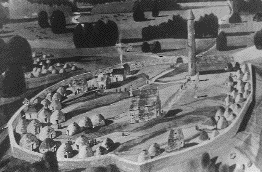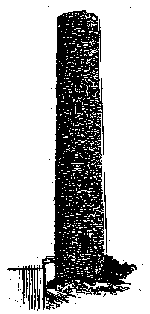
|
|
|
|
|
|
|
|
|
|
|
|
|
|
|
|
|
|
|
(A hundred thousand welcomes) Copyright © 1999 JAH. All rights reserved. |
Kells is the Anglicised version of Caill, meaning loss, or Cuan - Cian and is probably a union of both, meaning the "loss of Cian" or the place where the ancient Irish people lost their ally, the Great Ith Cian, king of Spain (Heberia / Iberia).
The name for Kells, in Irish, is Ceanannus Mor, which is an alternative spelling of Cian aneus Mor and means Great Cian from the South.
Cian, or Ith Cian, which was his full name, was the king of Breogan and Eber (Heberia-Iberia - the Hebrew's land) who was buried here, by his son Lughaidh* "Samildanach" (man of all crafts), after he was murdered by three Canaanite brothers, sons of Tyre - Tyrians (known in Irish legend as the sons of Turenn), whom he had previously driven out of Spain, for which they hated him and is the reason why they murdered him, by stoning him to death.
* Levi.
Ith Cian's son, prince Lughaidh, had left his dad (Ith Cian) and his homeland of Spain with his five ships and had come to Hebernia (the Hebrew's new land) to find some men from Breogan who had already migrated to Ireland and rule over them, which he did in Magh Bregia (Bregmag). Lughaidh had not sent word to his dad about where he went or that he was living in Hibernia (Ireland), and so, after a few years with no news from him, Ith Cian presumed his son was dead.
On her way from Jerusalem to Tara in Co. Meath, Ireland, with Jeremiah the Bible Prophet (Ollamh Fodhla); who was later buried in Cairn T at Loughcrew, nr. Oldcastle, Co. Meath; queen Teia Tephi the daughter of king Zedekiah of Jerusalem had stopped and stayed with Ith Cian and had been adopted by him as his daughter.
After queen Teia Tephi had arrived in Ireland and married Eochaidh the Heremon/Ard ri (High king), she met her step-brother Lughaidh and told him of Ith Cian's distress at believing his son was dead and that he should let his dad, whom she loved dearly, know that he was alive and well.
Weeks later, Teia Tephi (wrongfully deified as the Bo/Bovinda of Irish mythology); Eochaidh (wrongly deified as The Daighda of Irish mythology) and Lughaidh (also wrongfully deified in Irish mythology) were on their way from Tara to Navan Fort near Armagh to see Nuadh of the Silver Hand, who was the king of Ulster, when they bumped into Ith Cian who had received news that his son Lughaidh was still alive and in Ireland and had come to find him.
Ith Cian found out from Lughaidh that there was a rebellion against The Torah and Tephi; so he set off back South, to Howth, to sail back to Spain to bring his army to help his son and adopted daughter Teia Tephi, against the rebels, who were led by Bressail Mac Elatha (known in Irish legends as Bressail Bodibal [Bodibal - Opposer of Bo/Bovinda] who was buried at Dowth, [Dubad in old Irish] which means Darkness).
On his way back to Howth Ith Cian was seen by the three Canaanite brothers, who recognised him; followed and chased him; caught him up and killed him with stones, and then buried him under the stones.
When Ith Cian did not return with his army, his son, prince Lughaidh, went looking for him and found his grave. He then went in search of the three Canaanite brothers; found and slew them; then buried them under the same stones under which they had buried Ith Cian.
The most probable site for Ith Cian's grave would be the highest point in Kells; as that was the custom. You will probably have noticed that the cairns/tombs of people of note are normally built on hill-tops, so that the people will see their tombs when they look around and always remember them and follow the example and high-standards they set them in life.
Until the new Kells Garda Station was built, on ground that was specially and mechanically raised-up above it; against the wishes of the local people; the highest place in Kells was the mound, on the lower half of which Columba's House was built. It is therefore most probable that the mound under the upper-side of Columba's House is the grave of Ith Cian the king of Spain, after whom Kells was originally named Cian aneus Mor.

Later peoples and their religions made a habit of erecting their own buildings and churches on the sacred-sites of previous peoples, in order to try to absorb them; these focal-points and energy into their own religion
Kells Round Tower

The Round Tower is the other instantly recognisable landmark of Kells. It was built in the tenth century and stands ninety feet high, from the original street level to the base of its roof. It was built as part of the local defences against the Vikings and was used both as a lookout tower, and, being fireproof like Columba's House, as a place of refuge during attack.
Kells' round tower has six floors with no staircase, so that access was made more difficult for invaders; the only access being from one floor to the next by ladder. Each floor has only one window but the top is unusual, in that; unlike most round towers which have only four; this tower has five windows, that look out over the five ancient roads leading into the town; thereby assisting the lookouts in their job, by making it easier for them to be able to see people approaching Kells.
The five ancient roads out of Kells lead to:-
1. Navan Fort, Armagh via Carrickmacross;
2. Carlingford via Dundalk and Ardee;
3. Howth (Binn Eadair) via Tara and Dublin;
4. Uisneach via/near Mullingar;
5. Carrowmore, Sligo via Cavan.
The doorway to the tower; being raised approximately ten feet above the original ground-level; strengthened the tower and made it more difficult to attack with battering-rams and gain access by force. There is a window above the door so that the occupants could observe anyone attempting to gain access and enable them to defend it from above. Being circular, made it harder to batter-in, or remove stones from the tower, in order to gain access.
The Celtic-cross at the side of the Round Tower, has; carved on its western face; the eagle which is the emblem, or ensign, of the Tribe of Dan.
|
|
|
|
|
|
|
|
|
|
|
|
|
|
|
|
|
|